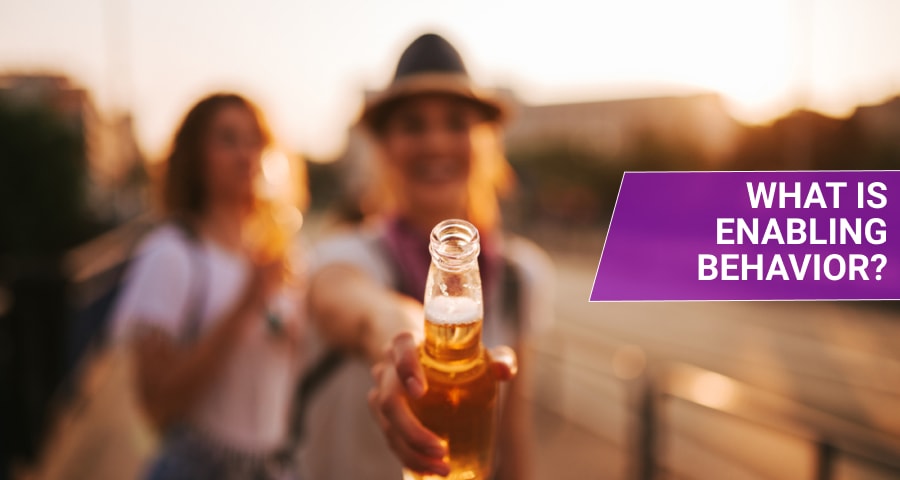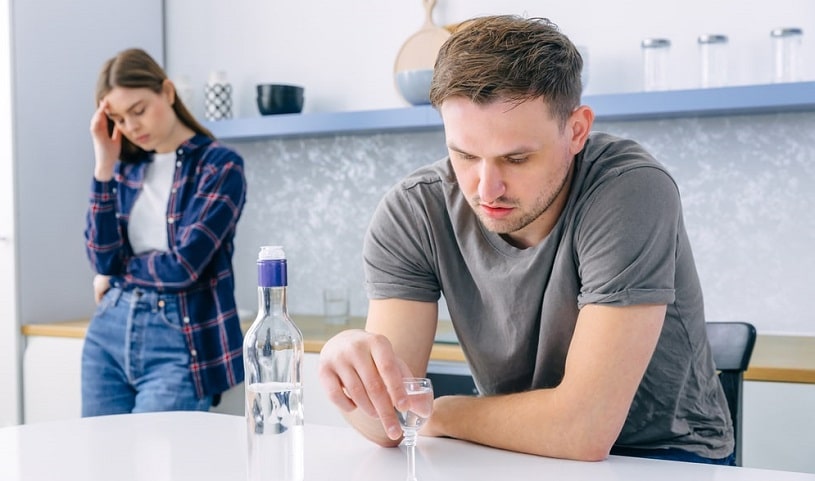
When it comes to addiction, many may not understand the meaning of the word ‘enable.’ In everyday usage, it means ‘allow’ or ‘permit’ an action. In the context of substance addiction, it is similar but a lot more detailed as to what constitutes enabling behavior.
Table Of Contents:
An enabler is never the addict themselves, but typically someone very close to them – either a loved one or a friend. These people may find it difficult to make tough decisions for the good of the addict and can end up enabling them, leading them further away from recovery. As a loved one of a person struggling with addiction, it is important to identify enabling behavior you might be showing.
What is an enabler? How to recognize enabling behavior and how to stop it?
What Is an Enabler?
An enabler is usually a friend or loved one of an addict who passively allows or permits addictive behavior in them. It can be by lending money or ignoring problematic behavior from the addict.
An enabler does nothing to prevent substance abuse and instead provides circumstances that make it easier for that behavior to continue. It is important to note that an enabler is not necessarily in support of the addiction and may want it to stop but continues to aid as they may feel they do not have the power to prevent it or fear the consequences if they don’t.
Enabling behavior will not help a person break the habit. Instead, it will only encourage the habit as the person becomes accustomed to getting away with drug use consequences.
Helping vs. Enabling
Many enablers believe that by exhibiting behaviors such as lending money, ignoring their behavior, or covering for an addict, they are helping them, either by keeping their addiction under control or protecting them from the consequences of their addiction.
There is a big difference between these two things. A person doing anything that allows the drug to be obtained, the drug abuse to continue, or mitigating the consequences of abuse, is enabling and not helping.

To truly help an addict, you must learn how to stop being an enabler and learn to do things that prevent them from continuing their abuse and set them on the path towards recovery. For instance, this can be organizing drug or alcohol intervention. In addition, motivational interviewing can help an addict understand their inner motivation and make the first step into recovery.
Signs That You Enable Addiction
Those close to addicts may believe that their actions are regarded as help, but they are often mistaken. Enablers need to recognize that their actions constitute enabling, stop them, and help the addict in a productive way that will assist in recovery.
The Signs of Enabling Addicts Include the Following:
- Not Addressing the Addiction: A loved one or someone close to an addict may recognize the severe damage that addiction is doing to the person’s life, but they never mention it without the seriousness that such a topic deserves. They may do this because they fear the reaction of the addict. The first step to getting better is to be able to identify the problem, so it is important not to act like it doesn’t exist.
- Supporting Them Financially: Anyone who knows that a person has an addiction and still gives them money likely knows the money is being used to fuel their dependence. By doing this, they are enabling drug use. Another way they enable addiction is to help take care of their financial responsibilities such as bills.
- Ignoring Problematic Behavior: Despite their attempts to hide their drug abuse at the start of an addiction, loved ones tend to notice troubling behavior such as staying out late or sneaking out at night. This behavior may continue later into the addiction, yet a loved one may shy away from addressing it sometimes due to fear or the notion that speaking it makes it more real than it is.
- Taking Care of Their Responsibilities: Addicts may have bills to pay, chores to do, pets or plants to take care of, and in some cases, even children to raise. By absolving them of these responsibilities, you make it easier for them to abuse drugs as they wish to.
- Blaming Others: Humans generally find it easier to blame someone else for their problems than take responsibility for them. This behavior can be seen in some of those close to addicts. It is painful to see someone they care about dealing with an addiction, so they look for someone else to blame. This is enabling because it means that you are making it so that the addiction was not the fault of the addict, which makes it easier to continue to enable addiction.
- Covering for the Addict: To fuel their addiction, some addicts may resort to stealing money and other people’s property. They may also get in trouble with the law under the influence of the drugs they are abusing. When law enforcement comes asking questions, the enabler will usually cover their tracks or verify whichever alibi they have. Covering for the addict like this lets them know that they have a safe space to continue their bad behavior, which will only perpetuate it.
- Prioritizing Their Needs: An enabler has their own life and important things that they have to get done, but they may end up putting the needs of the addict ahead of theirs. For instance, knowing that money is tight and rent will be due soon, yet lending money to an addict for alcohol or their substance of choice.
Enabling Behavior And Codependency Connections
Enabling addiction is not only harmful to the person dealing with the problem. It also affects the friends and family around that person negatively. A good example is the issue of codependency here. Individuals tend to mirror the codependent behaviors shown by observing people close to them. Codependency is a very unhealthy way of having a relationship with anybody, and, more often than not, it negatively impacts the quality of life of the parties involved.

When the codependent person is helping an addict who is a friend or family member, this person tends to focus on doing everything they want. The motive for doing this might be reasonable, like to support the addict in recovery or changing his behavior by being kind to them, but the approach does more harm than good. At the end of the day, the need to keep an addict satisfied all the time will end up affecting the happiness, welfare, and safety of the enabler. It’s a lose-lose situation. That is why those around an addict need to learn how to stop being an enabler as soon as they can.
Risk Associated with Enabling Addicts
Enabling is dangerous, not only for the addict but also for those close to them and who care about them. If you enable addiction, you push them deeper into their dependence on a substance and make it harder for them to see that their behavior is a problem (after all, the enabler seems to be in full support of them).
It is less likely for an addict to seek professional drug abuse treatment when an enabler is there to provide means to make their drug or alcohol abuse easier. There is no one to hold the addict accountable, and this can result in riskier drug use and a harder impact on their health.
Seeing the addict descend deeper into addiction and farther away from recovery can also weigh mentally on those who care about the individual and wish that they could get help, even the enabler themselves. It emphasizes why it is so important to learn how to stop enabling and get treatment for the addict.
How To Stop Enabling Behavior?
As someone close to an addict, you need to ensure you do not enable addiction or their behavior in any form, as enabling can result in a deeper addiction and increase the risks that the substances pose to the health of the addict.
It is essential to search through the signs of enabling addicts to ensure that one doesn’t enable addiction in any form. Helping an addict is distinct from enabling them. Those who suspect that they may be enabling can visit Al-Anon and Nar-Anon meetings to get help, speak to other people who have a loved one dealing with addiction, and learn more about how to stop enabling.
If You Need to Find Out How to Stop Enabling, Here Are Some Tips to Follow:
- Stop financial aid: A loved one or friend needs to stop giving money to an addict when they know that they will use it to fuel their addiction. Stop paying bills for them and providing a fall-back option.
- Allow consequences to take effect: This includes both the consequences you set and consequences from other people, such as work or school. If you tell an addict that you will revoke their use of a car for some time, you must follow through on them. You should also not help them appeal suspensions that might occur at school or work.
- Stop taking on their responsibilities: An addict has commitments, and no one should take these up for them while they’re using drugs or alcohol. Life goes on, even when they are using a substance. For instance, don’t help them wash their clothes or clean their room if this is something they should be doing themselves.
- Do not blame the addiction on anyone else or make excuses: Addiction is hard to deal with, but it is no one’s fault but the addict themselves. Do not make excuses for them as to why they continue to abuse a drug or why they started in the first place.
- Set boundaries: Boundaries make it very clear to an addict that you do not approve of their habit and want it away from you. You can tell them that you do not want the substance in your home, for example.
The Importance of Stopping Enabling Behavior
The importance of stopping any enabling behavior that you may be demonstrating cannot be overstated. Enabling only makes an addiction work, and you are not helping the addict in any form apart from going down the wrong path.
To truly help an addict, it is vital to get the professional treatment that can set them on the right path.
Hope Without Commitment
Find the best treatment options. Call our free and confidential helpline
Most private insurances accepted
Find Drug Rehabilitation Centers Near You Anywhere In the US
Addiction Resource team has compiled an extensive list of the top drug rehabilitation facilities around the country. Use our locator tool to find the best centers near you.
Page Sources
- Falkin, G. P., & Strauss, S. M. (2003). Social supporters and drug use enablers: a dilemma for women in recovery. Addictive behaviors, 28(1), 141–155. https://pubmed.ncbi.nlm.nih.gov/12507533/
- Brown, S., Tracy, E. M., Jun, M., Park, H., & Min, M. O. (2015). Personal network recovery enablers and relapse risks for women with substance dependence. Qualitative health research, 25(3), 371–385. https://www.ncbi.nlm.nih.gov/pmc/articles/PMC4608244/
- Cermak T. L. (1989). Al-Anon and recovery. Recent developments in alcoholism: an official publication of the American Medical Society on Alcoholism, the Research Society on Alcoholism, and the National Council on Alcoholism, 7, 91–104. https://pubmed.ncbi.nlm.nih.gov/2648500/
- Lander, L., Howsare, J., & Byrne, M. (2013). The impact of substance use disorders on families and children: from theory to practice. Social work in public health, 28(3-4), 194-205. https://www.ncbi.nlm.nih.gov/pmc/articles/PMC3725219/
- Mulry, J. T. (1987). Codependency: a family addiction. American family physician, 35(4), 215-219. https://pubmed.ncbi.nlm.nih.gov/3565221/


 Reviewed by:
Reviewed by:  Written by:
Written by: 

 FindTreatment.gov
FindTreatment.gov